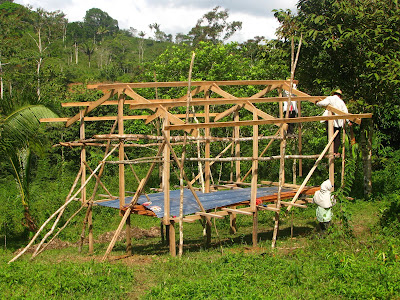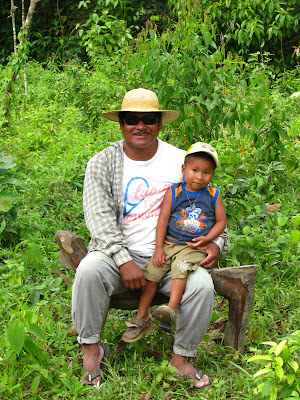So I've been working on building my house for the last few weeks, and it's not quite done, but almost there. I'm hoping to be able to move into the house in about 2 weeks. The house should end up being about 17x14 with a 10 foot ceiling. It may be small by American standards, but here in Panamá that's pretty big. Many families with 3 or 4 kids live in similar size houses. The total bill should run about $400 which is alot on my salary, but once it's built I won't have any rent. I'm definitely looking forward to living on my own. I've missed the privacy and independence of cooking my own meals. Below are some pictures I've taken during construction.
You may wonder how to build a house in the jungle. I believe my fellow volunteer Alan has described the process best.
You may wonder how to build a house in the jungle. I believe my fellow volunteer Alan has described the process best.
So I know the burning question in a lot of people's minds is;
How do you build a sweet house in the jungle?
For this I've made a simple easy to use guide for everyone who would like to build their own.
Step 1) Find a community of highly skilled indigenous people, and tell them you'll take pictures of them building a sweet house.Step 2) Sit back and watch.
Yup, that's basically it. I just saw where they tell me to saw, and hammer where they tell me to hammer.
 Putting in the posts to elevate the floor.
Putting in the posts to elevate the floor. Laying out the floor plan.
Laying out the floor plan.
Jesus, my host father, contemplating what to do next.

Not bad for a day's work.

Putting up the frame for the walls.
 The iguana. People couldn't stop laughing the first time I called it a "sawhorse." Apparently, that word doesn't translate well directly.
The iguana. People couldn't stop laughing the first time I called it a "sawhorse." Apparently, that word doesn't translate well directly. Riding the iguana.
Riding the iguana.
OSHA?!? Who are they? Panamanian do everything with their machetes, including planing wood. So far no fingers have been lost in the construction of my house.


The two pictures are NOT related, but it wouldn't be a work day without the chicha fuerte.



Frames up, and as usual the sky provides a dramatic backdrop.

Prepping for the roof. Total cost for the roof $280.88.

 My new neighbor Gregorio and his son.
My new neighbor Gregorio and his son.
Ready for the floor.


Floors almost done.


Each board has to be planed to fit before it can be put down.
And that's the status so far. Roofs on, floors 3/4 done, and we're waiting on the wood for the walls and more nails (which I bought today.)
Hopefully, my next post will be the house fully finished.
And that's the status so far. Roofs on, floors 3/4 done, and we're waiting on the wood for the walls and more nails (which I bought today.)
Hopefully, my next post will be the house fully finished.
6 comments:
Great photos, Josh! Amazing what they can do with a chainsaw and a machete! Can't wait to see the finished house. We missed you on your birthday.
Love, Mom
very cool. and it looks like a very good sized place actually and beautiful with all the green surrounding it. How many days total will the project have taken? Who were you paying rent to before? If it's your host family, that makes it all the more amazing that they are nice enough to help build you a new pad. Enjoy being a "home owner"
hey josh,
your house looks awesome. I know this is wierd, but what did u put on the questionaire that asks questions about how you feel about certain things at your site...(privacy, running water, religious, dugout canoe access only.....)
I hope your enjoying your home =)
Katharine,
When the house is finished (hopefully 2 weeks from today,) it will have taken 8 work days in total to build. I'm currently paying $30 a month to my host family which is intended to cover food. My host family has been really great (I don't have some of the horror stories that other volunteers have.)
Valeria,
The Sustainable Agriculture sector might do it differently (I'm an Environmental Health volunteer,) but we didn't have a questionnaire that we filled out. Instead every volunteer had an interview with our APCD (that's our sector leader.) The questions that you asked aren't really addressed unless you feel very strongly about one of those areas. The main questions are would you prefer a latino or indigenous site, how accessible would you prefer (no sites have a hike in of more than 2 hours from a road,) and what type of project would you prefer. Usually, the APCD already has a site in mind for you before the interview, and the interview is to ensure that you don't have any major objections to the site he has selected.
As an agriculture volunteer, you may or may not have running water, and will probably not have electricity. During your first 3 months in your site, you will be required to live with a host family, and should expect to have very little privacy. Of the almost 200 volunteers in Panama, probably less than 8 are in sites only accessible by boat. As an agriculture volunteer your primary projects are usually organic farming, fish tanks, and rice tanks though every volunteer chooses their own projects.
Hope that helps. Feel free to email if you have other questions.
Post a Comment